Iowa City artists must balance creativity, financial reality: 'You hope that you can find an audience'
If it wasn’t for her friends, Roneshia Robichaux wouldn’t have switched her major from biology to the arts while she was a student at the University of Louisiana Monroe.
If Robichaux didn’t change majors, she may not have attended the University of Iowa, at least not to get a master’s degree in painting and drawing, something she completed this year.
While her interest in the arts didn’t begin during college, changing her major has led Robichaux further down her creative path.
“I was doing biology as a way to 'people-please' some members of my family and just trying to make everybody else happy,” she said to the Press-Citizen. “Once I got into it and realized that it wasn't for me, and started getting the encouragement from different places, I was like, ‘OK, well, maybe I can do something that I actually liked.’”
As Iowa City works to be the self-proclaimed "Greatest Small City for the Arts," it must face challenges for visual artists in pursuit of their craft. Still, these creatives find community, mentorship and opportunities to support their work.
In a three-part series, the Press-Citizen is exploring the visual artists that live and work here; the challenges some face in pursuit of their creative work; and what can be done to better support visual artists in Iowa City.
In this first installment, five visual artists discuss their craft, how they decided to pursue their respective interests, and their ability to find success amid time and financial constraints.
Robichaux is a multidisciplinary artist who is currently working with clothes, exploring how garments are a form of expression that can be especially important within certain communities.
More: Iowa City art installation takes listeners to 10 parking lots, creating discovery and belonging
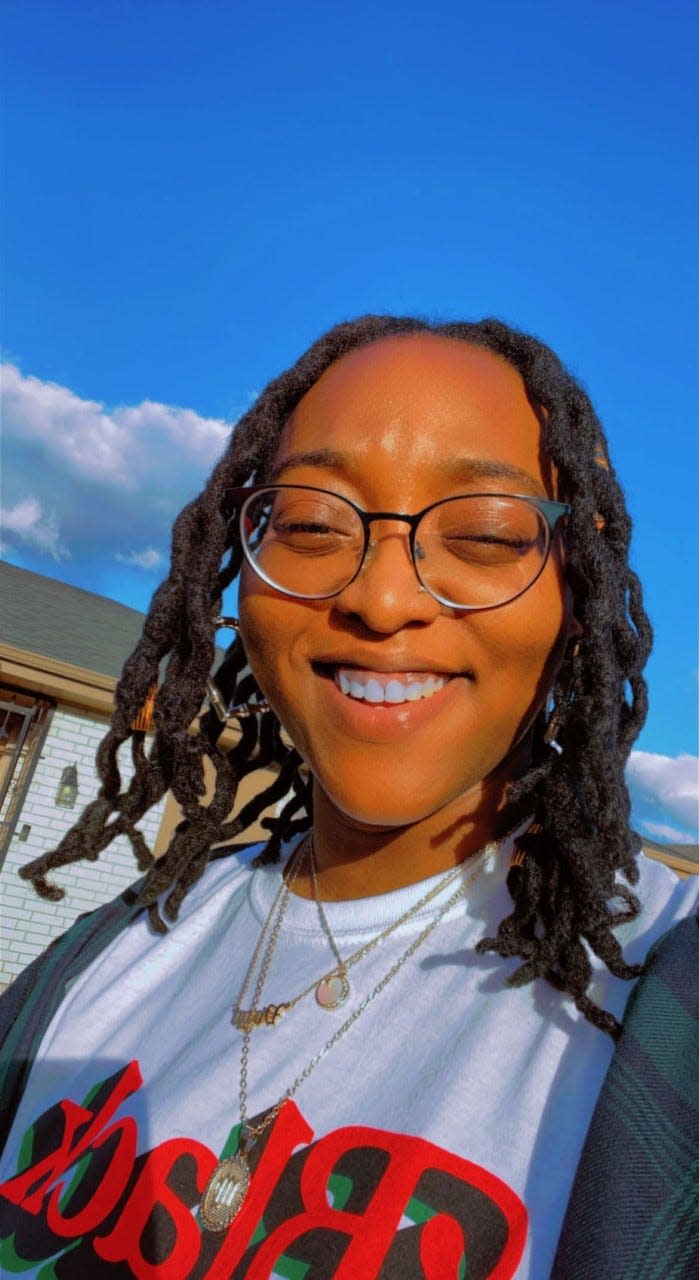
“One of the biggest things that I value in my art is taken from different places and hearing people's stories and then developing something out of that. Because I think those stories are important to hear and to talk about … and create this conversation so that it continues outside the art,” she said.
‘I'm trying to take on as much as I can’: Financial stability in the arts
Like Robichaux, Drew Etienne is a multidisciplinary artist who has his master's in painting, drawing and printmaking.
Among the earliest paid opportunities Etienne had was through public art while he lived in Bloomington, Indiana, where he completed his undergraduate schooling.
When he came to Iowa with his partner, both going to UI for graduate school, Etienne worked on more public art projects, including the Linn Street murals that brought colorful flowers to the northside of Iowa City.
Public art makes up the majority of his income, he said, particularly murals. In an email to the Press-Citizen, Etienne said that the majority of mural work he's seen pays between $1,000 and $8,000, depending on size. A few, more competitive jobs can fetch $10,000 to $20,000.
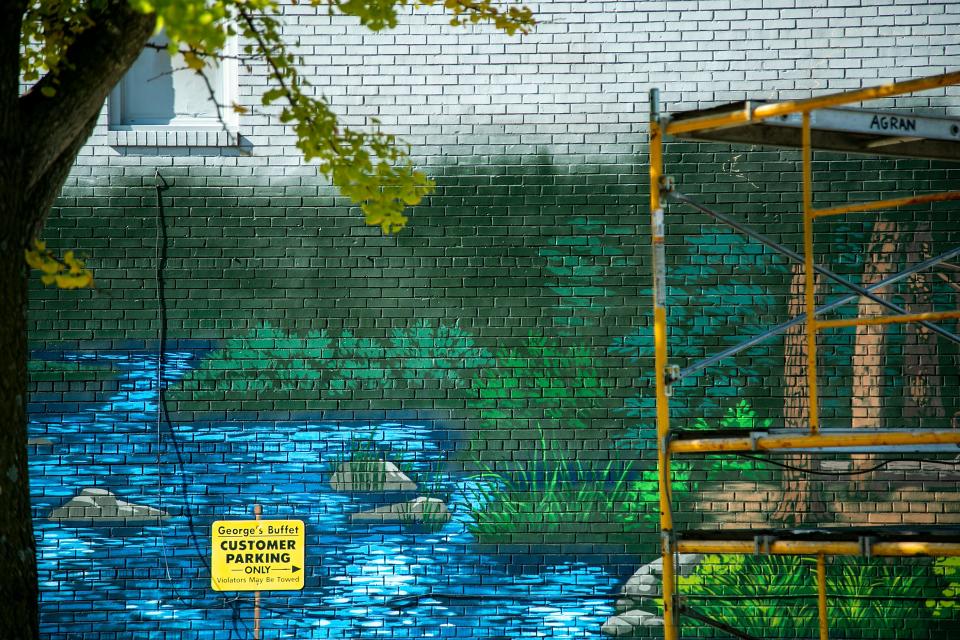
He has done smaller projects and design work, which he's had commissions for "as low as $500."
As someone that's self-employed, Etienne spends much of his time finding work or -doing design work on an already agreed-upon job or in an attempt to be selected for a job.
“You kind of have to put everything else aside for a while and just concentrate on that,” he said. “And so I feel as far as time-wise, sometimes what I want to be doing with my own work might suffer as far as like, well, I have to just only do this at least for this time frame. … I always make the analogy of when I'm talking with my other artist friends I feel like I am a squirrel that’s constantly gathering nuts for the winter. I'm trying to take on as much as I can to make sure that I can make ends meet.”
Though he’s shown work at galleries plenty of times over the past decade and has sold work through that, Etienne felt it was something he was spending more money on than getting from it.
“That was always difficult as far as the financial end of it. … You make the work that you want to make and then you hope that you can find an audience for it,” he said.
Etienne’s growing experience with public art, combined with the difficulties of having enough space for his painting, caused him to branch into sculpture. But storing art remained a challenge.
Public art became a solution for Etienne. The large walls he paints on become the canvases he doesn't have to store or worry about transporting.
“In the last four years, it's ramped up on my goals to find opportunities where I can direct the conceptual and thematic things that I'm interested in, which is usually environmental things, getting that into a public art space as opposed to just functioning in the gallery space,” he said.
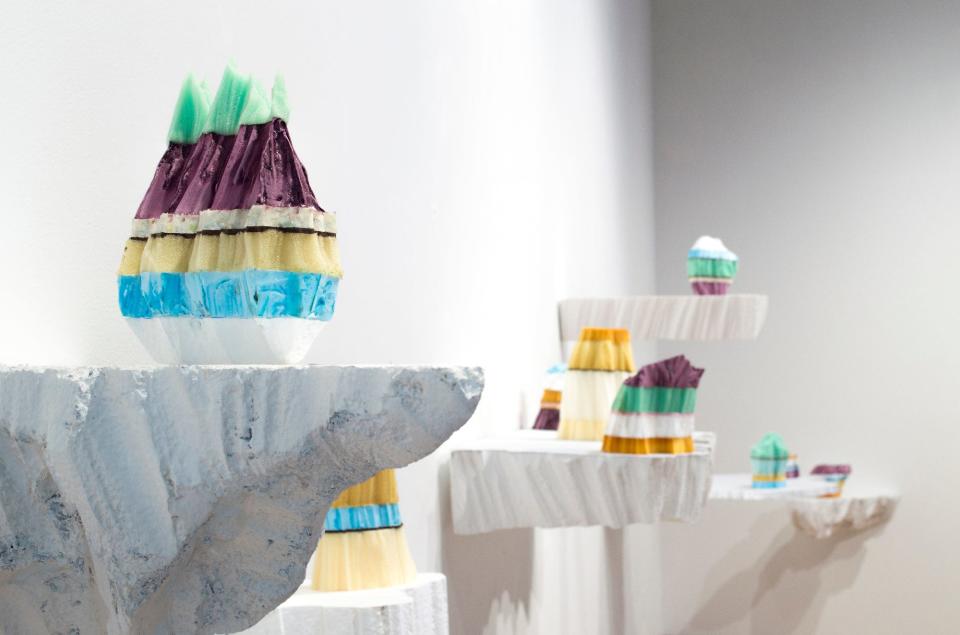
If Etienne has found opportunities through murals, Robichaux has found that garments are easier to sell than paintings. She has a 9-to-5 job that helps pay the bills and buy art supplies.
Meanwhile, Jenny Gringer said she's come to the conclusion it’s not possible for her to make a living as an artist.
The Iowa City resident is a printmaker whose work has included messages of peace, joy and support. She spearheaded the Iowa City Joy March, where participants get loud — and dress louder — to bring some cheer to onlookers downtown.
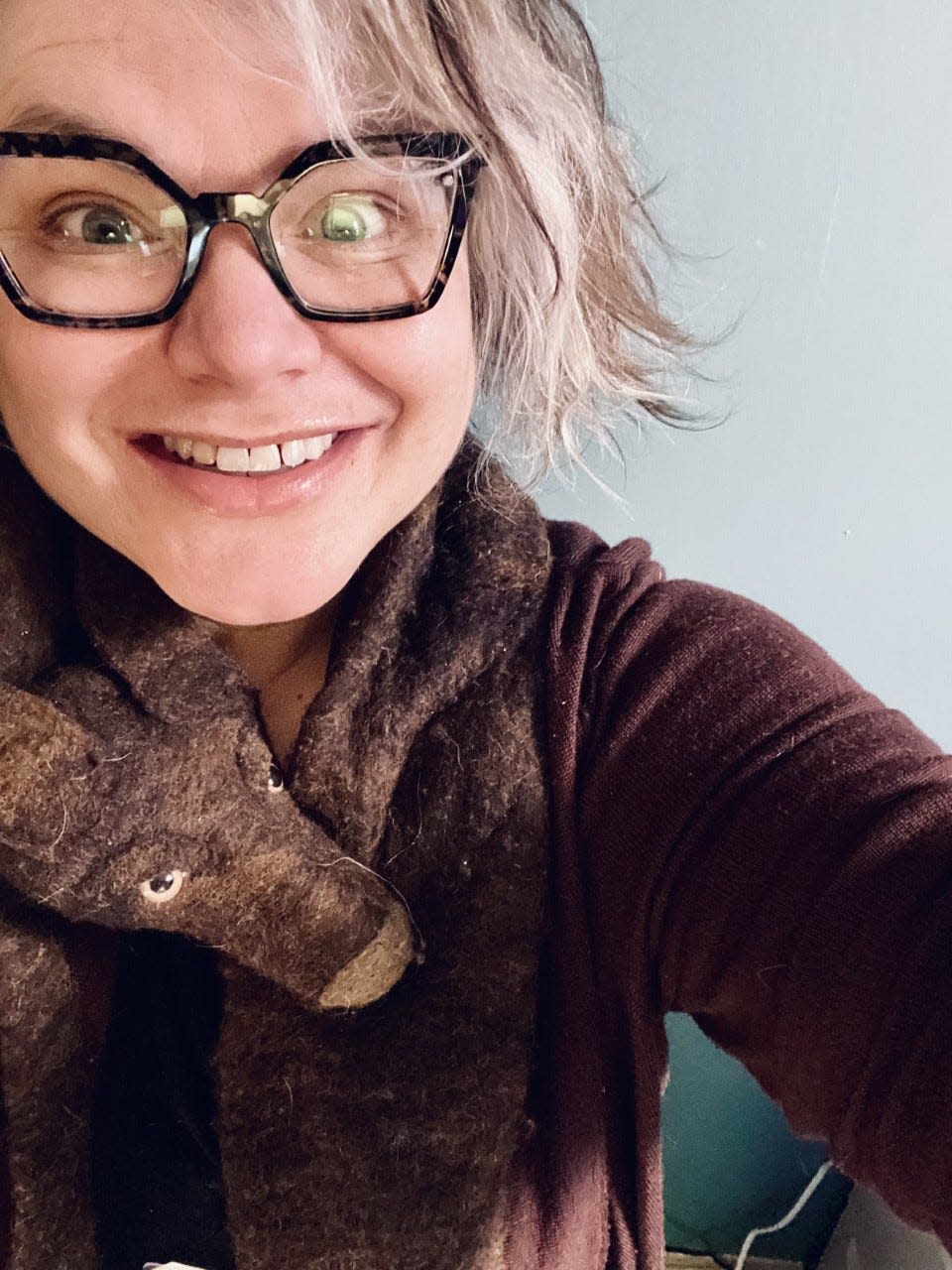
"I went to this, it was like a little art firm in Wisconsin back in about 2008. I thought, 'Well, I'm just going to pretend I'm an artist and take this class and see what it's like.'" she said. "And it really changed my trajectory. I just thought, 'Wow, this is something I've always enjoyed, but I've never delved into.'"
The printmaker had been working part time. She thought all she had to do was make a small amount of money in her creative work and she’d be fine.
What she found was unpredictability and stress while trying to raise young children.
She needed a predictable income, she said, and found it at UI, where she has worked for more than two decades.
Even when she does well at an art show, keeping in mind material costs and time, it isn’t nearly comparable to what she would need to make to become a full-time artist.
"I think for other people, you don't have that 'fallback' thing you can go to for work, and I do. So, for me, it's just easier to work and make art, because then I don't have to think about what's going to make money. So it’s a lot more liberating as an artist," she said. "I feel a lot more freer than I think other people are.”
More: Plan your visit to Iowa City's new Stanley Museum around these 9 pieces of art
'It’s that kind of curiosity that I think carried me': Exploring creative interests
Gringer’s approach to finding time for her creative practices is straightforward.
She just does it.
Since the pandemic, Gringer said she’s no longer at the pace she was previously in terms of artmaking, recognizing her need for rest.
She’s opting for things that are fun, no longer chasing shows for her work.
“I'm just making work as it feels important to me and then doing maybe more public things,” she said. “I don't really know where I'm going, but I am always pleased that I don't have to know.”
Though it can be draining to have a job and create, Robichaux has made an effort to continue with her craft. She often uses the weekend for her art.
“Just forming an idea in your head or grabbing one piece of fabric and holding on to that scrap and saying, 'OK, I'm going to use this in the future,’” she said. “I have a whole bag full of scrap garments and materials that I can use for later ideas, but just collecting those items so that you have them for a future date is something that I've been really interested in and thinking about, so that it keeps me moving when I actually can't work on art.”
Deanne Wortman can relate to that. The longtime multidisciplinary artist's work has ranged from printmaking to drawing and hot foil stamping.
Wortman finished her studies in the 1980s while raising a family, working as a bus driver and later at the Iowa City Public Library. She worked alongside Virginia Myers, an innovator in foil imaging and professor emerita at UI, taking Myers’ position when she was no longer able to teach. Wortman was the director of the Virginia A. Myers NEXUS of Engineering and the Arts in the College of Engineering, a program that facilitated partnerships across the two departments.
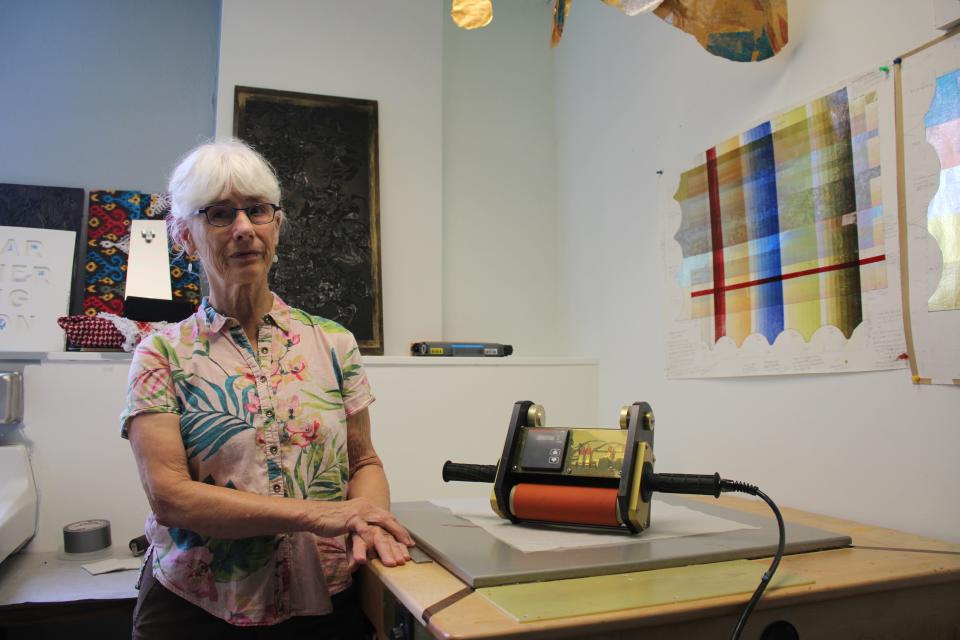
Throughout her different careers, Wortman found a way to incorporate her artistic practices — storytelling with children at the library and performances as a bus driver — and remain creative.
“(My jobs) were all oriented towards the things that I’ve always (had an) interest in,” Wortman said. “I was fortunate that way, because a lot of people don’t find jobs that actually become embedded in their life and their world view.”
It was as the director of NEXUS of Engineering and the Arts that she emphasized curiosity to students, something she practices herself while observing the world around her.
“I've had the opportunity to do murals with people. I've had the opportunity to teach within the university. I've had the opportunity to create a program that I hope is benefiting especially the engineering students to open their minds,” she said.
“Working with people, sharing my joy and interest in curiosity if the person is willing to go there, and that allows me to explore whatever I'm also seeing and doing. … It’s that kind of curiosity that I think carried me."
‘I definitely feel a part of a community’: Finding kinship within the arts
Nancy Romalov was already in her 50s when she began pursuing woodworking. She’s 76 now.
She had the privilege of not having to make money in woodworking when she began. Not that she didn’t want to, Romalov said.
“I had already had a career. I was in a financially fairly stable situation where I didn't need to hit the ground running. … I could work into it as much as I wanted or didn't want, so I had the privilege. And I ignored a lot of advice in the beginning because people said, 'Oh, you have to do this if you want to make money,'” she said.
Romalov didn’t have to make pieces she didn’t want to, instead exploring her materials and putting her “whole body and soul” into woodworking.
Woodworking began for Romalov when a friend of hers built a cabin, and she wanted to furnish it. This was a new task despite the fact she'd worked with her hands her whole life.
She made chairs and tables, “flying by the seat of my pants” and loving every step of it.
But she realized she needed to know how to do her work better.
She took some woodworking classes at Maharishi International University in Fairfield in 1999, while balancing her responsibilities teaching part-time. In the beginning of Romalov's woodworking career, she had also taught part-time at UI and Cornell College.
The short time there set Romalov down the path of woodworking, her career ever since.
She apprenticed with a furniture maker, later taking his spot in a cooperative shop when he and his family moved, becoming one of the four people who share the space and some of the larger pieces of equipment.
“I just have to pinch myself how lucky I have been through this whole process,” she said. “I've just met some incredible people who have helped me and push me and I've learned from, and this group of guys in the shop. We’re family.”
Early in Romalov’s career, she was asked to put her furniture in an artisan’s gallery downtown. The exposure resulted in sales almost immediately, a loyal clientele and business via word of mouth.
“Networking is so important in this business, and being part of a group that is like-minded,” she said.
For Romalov, that’s being part of the Eastside Artists collective in Iowa City.
Mentorship has followed Robichaux throughout her career, from a drawing professor who she began to do murals with to a local artist who helped her utilize found materials to work on outside of canvases.
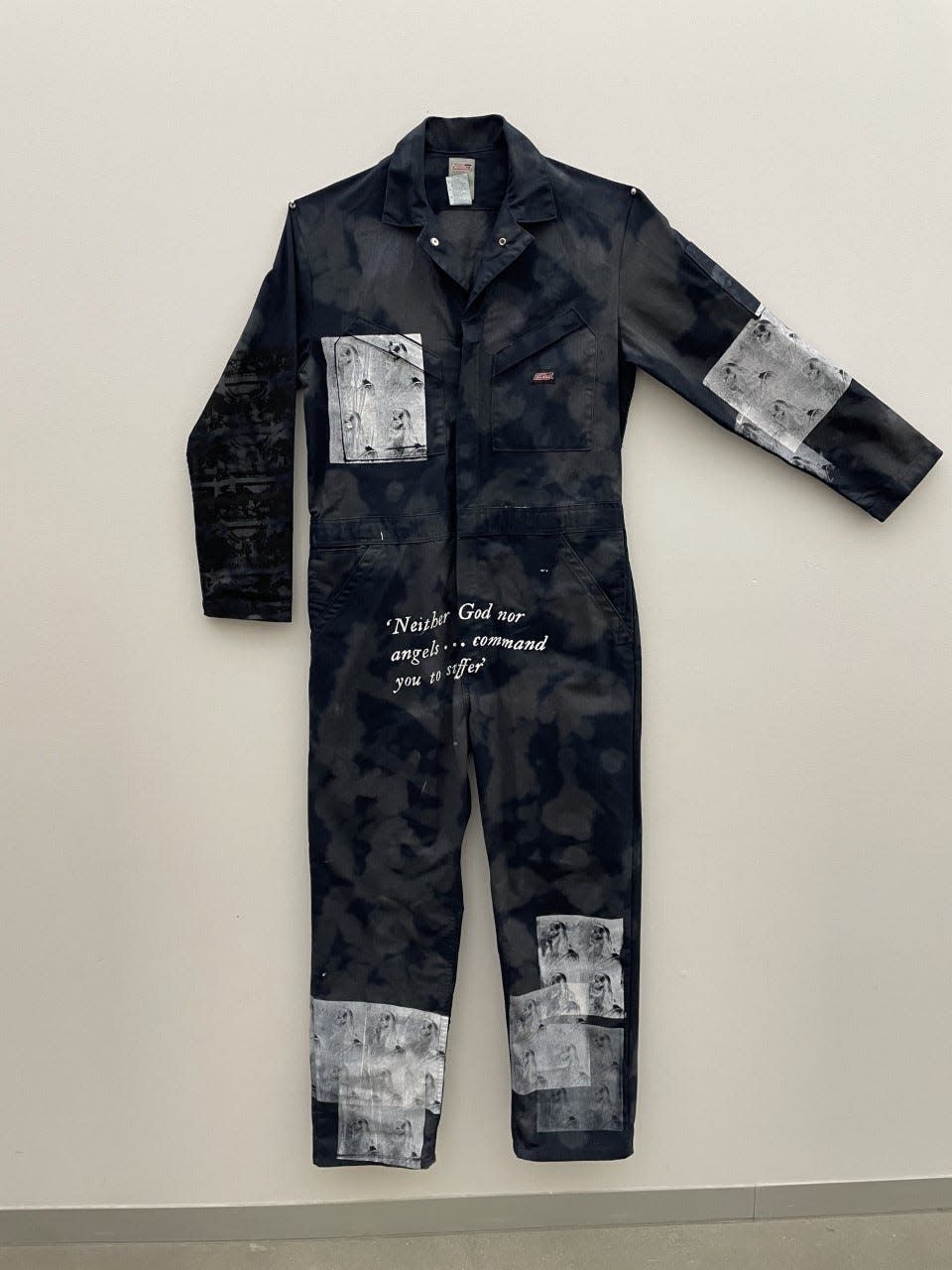
That continued in the Iowa City area, with Robichaux crediting T.J. Dedeaux-Norris, a UI associate professor of painting and drawing, and Humanize My Hoodie cofounder Andre Wright.
Both provided her space and opportunities to work through her ideas, she said.
Making connections might especially be important in the arts, particularly in Iowa City, Gringer said.
Talking to people, sharing work and meeting others through organizations like Public Space One and the Iowa City Press Co-op fosters appreciation for others’ work and opportunities to connect others to work that may suit them, Gringer said.
“I definitely feel a part of a community of people who lift each other up,” she said.
Art doesn’t need any special training, Gringer said. People can just do it, like she did.
“Your trajectory is never set,” she said. “You can change your life. You can do what you want at any age, and success is really self-defined, too.”
Paris Barraza covers entertainment, lifestyle and arts at the Iowa City Press-Citizen. Reach her at PBarraza@press-citizen.com or (319) 519-9731. Follow her on Twitter @ParisBarraza.
This article originally appeared on Iowa City Press-Citizen: Iowa City artists discuss pathways to the arts amid financial reality

